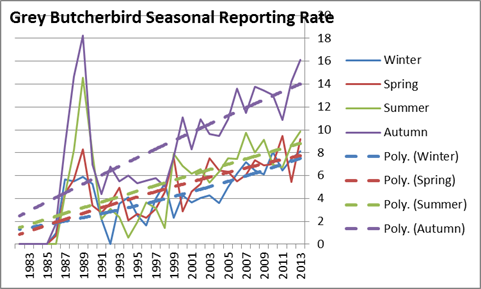Around my home, I see geckoes far more often than small skinks (without particularly looking, though neither often). I think geckoes are more active in cooler
conditions than skinks. The Grey Butcherbird has been a regular (most weeks if not days) around my home in the past year, which was not the case years ago. It could simply be a historical process. That the species is learning to adapt to suburban living much
later here, than in other eastern cities. That “In most years the autumn reporting rate is higher”
I suggest relates more to the migration of honeyeaters and other small birds as a food source, than activity changes in the few small reptiles.
Philip
From: Wallaces [
Sent: Saturday, 24 June, 2017 7:56 AM
To: Canberra birds
Subject: FW: [canberrabirds] Skinks as a food resource in winter
Thanks Geoffrey. Your comments prompted me to look at the seasonal reporting rates as I would expect that skink activity is lower in winter. The graph below shows the general COG data (with dotted second degree
polynomial lines). The trend is for increased reporting rates in all seasons with winter, spring and summer moving at similar levels and rates of increase. In most years the autumn reporting rate is higher (1990, 1998, 1999 being the exception) resulting in
a noticeably higher and increasing trend. Based on the increasing reporting rates, something is working in the butcherbirds favour.
Steve


